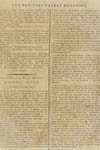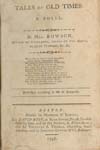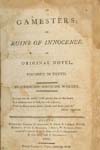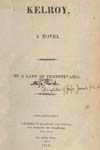_______________________________________________________________________________________
 |
Anna (i.e., Ann Eliza Bleecker?). St. Herbert: A Tale. In The New-York Weekly Magazine (February to June, 1796). St. Herbert was serialized in The New York Weekly Magazine in 1796, making it one of the earliest American Gothic novels. Here the Gothic castle is Americanized as an old manse surrounded by a dark forest. The doors creak, sighs come from drafty corners, and the evil spirit of its original aristocratic owner blights the lives of three generations of its inhabitants. The anonymous author “Anna” has never before been identified, we believe she is Ann Eliza Bleecker because several other writings by her were published at about the same time in the same magazine, some also signed “Anna.” Bleecker is known mainly as the author of an Indian captivity narrative, The History of Maria Kittle, which dwells on the horrors of life in the wilderness in a similar style. Bleecker endured unspeakable horrors during the Revolution when her lonely frontier farm was overrun twice by the enemy. She died in 1783, deeply depressed, her spirit broken by her suffering. If she is indeed the author of St. Herbert, it was written some fifteen years before it was published, making it not only the earliest American gothic, but the earliest American novel, period. |
| |
|
 |
Susanna Rowson. Reuben and Rachel. (Boston, 1798). Susanna Rowson is best known as the author of Charlotte Temple, which Philadelphia publisher Mathew Carey made into the first American best-seller while Rowson was living here in the early 1790s. In 1796 she moved to Boston and published several more novels that were markedly less successful. One of them, Reuben and Rachel, has gothic elements: it is set in the 15th century and begins in a castle, but later the action moves to New England. |
| |
|
 |
A Lady of Massachusetts (i.e., Sally Barrell Keating Wood). Julia and the Illuminated Baron. (Portsmouth, 1800). Set during the French Revolution, this decidedly Gothic tale concerns the villainous Count de Launa who abducts the virtuous orphan Julia, who turns out to be a member of the Bavarian Illuminati, the secret society that started the revolution. Somehow middle-class values triumph over aristocratic vices.
|
| |
|
 |
Caroline Matilda Warren Thayer. The Gamesters. (Boston, 1805). Warren was one of several imitators of Charles Brockden Brown. Her novel features a prolonged and ultimately futile struggle by a virtuous New England youth against a devious tempter who leads him into many vices, such as high living and gambling. It is partly set in that sink of iniquity, Philadelphia. |
| |
|
 |
(Left) A Lady of Cape Francois (i.e., Leonora Sansay). Secret History; or, the Horrors of St. Domingo (Philadelphia 1808). Sansay also wrote this harrowing short novel based on her experiences during the Haitian revolution. It too is anonymous, but it is cast as a series of letters to Burr; a partial acknowledgement of both her authorship and their relationship.
A Lady of Philadelphia (i.e.,Leonora Sansay). Laura. (Philadelphia, 1809). Historical Society of Pennsylvania. Leonora Sansay, the daughter of a Philadelphia tavern keeper, was a prolific gothic novelist better known to history as Aaron Burr’s on and off lover. The heroine of Laura lives in sin with a Charles Brockden Brownian evil genius (based on Burr?), a seducer seduced by his own delusions of moral superiority. |
| |
|
 |
An American (i.e., Leonora Sansay). Zelica, the Creole. (London, 1820). Twelve years later Sansay revised and expanded The Horrors of St. Domingo into this three-volume, 800-page novel published in London. The other works listed on the page facing the title, said to be by the same author, were either never published, or else they are unrecorded, like Zelica itself was until this unique copy was discovered in 1996. |
| |
|
 |
A Lady of Pennsylvania (i.e., Rebecca Rush). Kelroy. (Philadelphia, 1812). Compared with her contemporary Leonora Sansay, Rebecca Rush was from the opposite end of the social spectrum – she was Benjamin Rush’s niece – but even more obscure and underrated as a novelist. The villain in this piece is a widowed mother, Mrs. Hammond, who cynically manipulates her daughter into marriage with a wealthy man by forging faithless letters from her real true love, the black-clad romantic Kelroy, whom Mrs. Hammond hates with a passion extreme even by Gothic standards. Rush Gothicizes the novel of manners as exemplified by Jane Austen, another close contemporary. |






